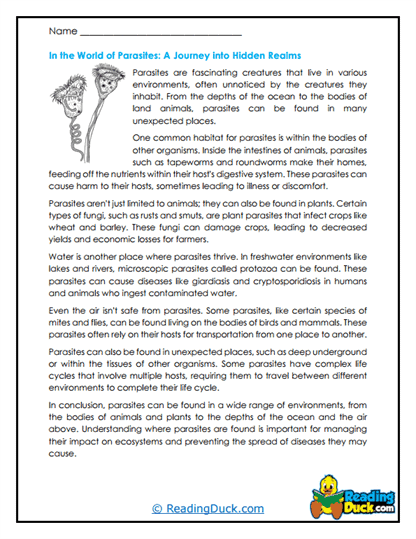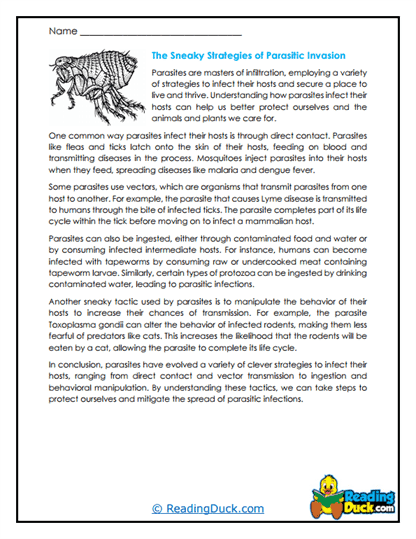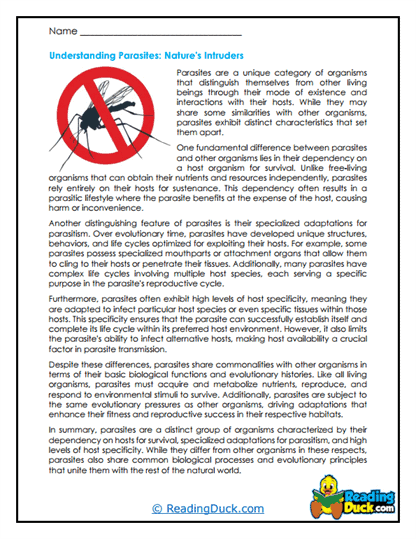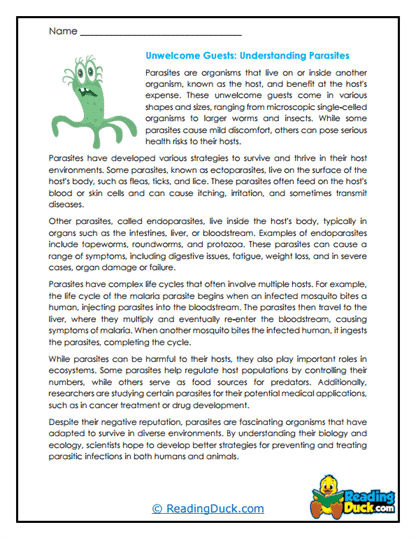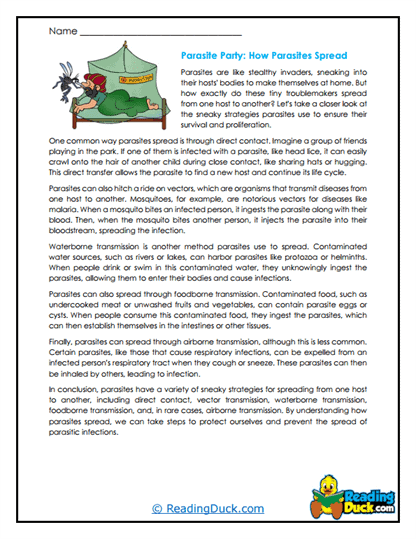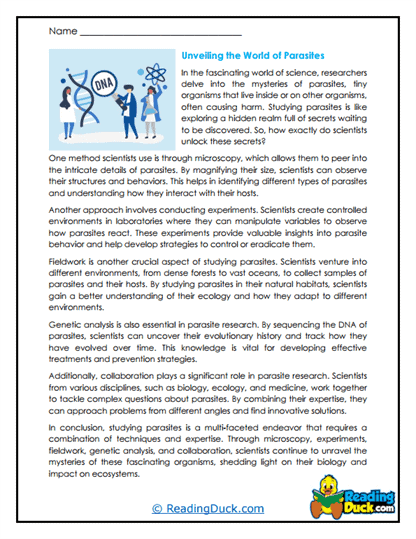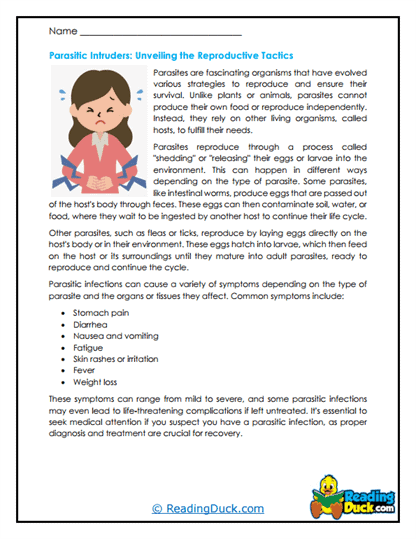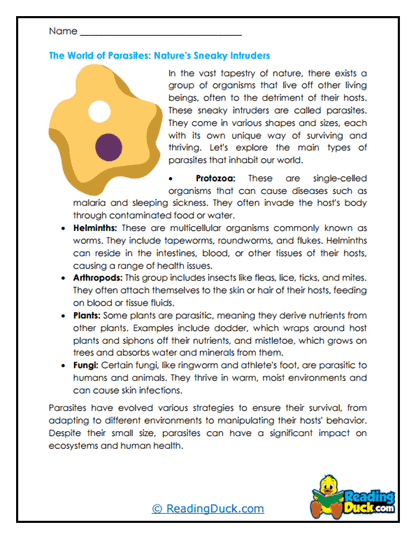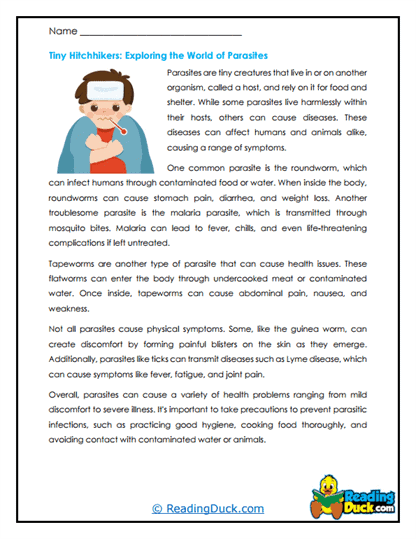Parasites Worksheets
About Our Parasite Worksheets
Our Parasites Worksheets offer an engaging and thorough exploration into the world of parasites-organisms that live on or inside other organisms (hosts) and rely on them for survival, often causing harm in the process. As a subtopic under the broader categories of Biology and Microbiology, this collection delves into the different types of parasites, their life cycles, how they affect their hosts, and the ways in which parasitic infections are prevented and treated. These worksheets are designed to make learning about parasites both educational and intriguing, providing students with a solid understanding of these fascinating organisms.
This collection contains several worksheet sets, each focusing on different aspects of parasites. Each worksheet set includes:
- Multiple Choice Questions: These questions assess students' comprehension of the reading material, ensuring they grasp the key concepts and details presented.
- Short Answer Questions: This section encourages students to articulate their understanding in their own words, reinforcing their knowledge and improving their ability to communicate scientific information effectively.
- Open-Ended Questions: These questions invite students to share their personal thoughts, opinions, and reflections on the material, fostering deeper engagement and critical thinking.
An answer key is provided for every question sheet, making it easy for educators and parents to review students' work. All worksheets are available in PDF format, allowing them to be easily viewed electronically, downloaded, and printed for use in various educational settings.
Understanding Parasites: The Complex World of Host-Parasite Relationships
Parasites are a diverse group of organisms that can have profound effects on their hosts, ranging from mild discomfort to severe illness or even death. Studying parasites offers insights into the complexity of life cycles, the adaptability of organisms, and the delicate balance between host and parasite. When introducing students to parasites, it’s essential to cover the different types of parasites, their life cycles, the diseases they cause, and their ecological and medical significance. Here’s a detailed breakdown of the key aspects of parasites covered in this collection:
Types of Parasites: Parasites can be broadly classified into several categories based on their characteristics and the nature of their relationships with their hosts.
- Protozoa: These are single-celled organisms that can cause diseases such as malaria, amoebiasis, and giardiasis. Students will learn about the structure of protozoa, their modes of reproduction, and how they infect hosts through water, food, or vectors like mosquitoes.
- Helminths: These are multicellular worms that include roundworms, tapeworms, and flukes. They can cause a variety of diseases, including schistosomiasis and hookworm infection. Understanding the life cycles of helminths helps students grasp how these parasites spread and how infections can be prevented.
- Ectoparasites: These parasites live on the surface of their hosts, such as lice, ticks, and fleas. Ectoparasites can cause skin irritations and transmit diseases like Lyme disease and typhus. Students will explore how these parasites attach to their hosts, feed, and sometimes act as vectors for other pathogens.
Life Cycles of Parasites: The life cycles of parasites are often complex, involving multiple hosts and developmental stages.
- Direct Life Cycle: Some parasites have a direct life cycle, where they complete their development within a single host. Students will learn about examples such as hookworms, which can infect a host directly from contaminated soil.
- Indirect Life Cycle: Many parasites have an indirect life cycle, requiring multiple hosts to complete their development. For instance, the malaria parasite Plasmodium requires both humans and mosquitoes to complete its life cycle. Understanding these cycles helps students appreciate the intricate strategies parasites use to survive and spread.
- Transmission and Infection: Students will explore how parasites are transmitted from one host to another, whether through direct contact, contaminated food or water, or vectors like insects. This knowledge is crucial for understanding the epidemiology of parasitic diseases and the challenges in controlling their spread.
Impact of Parasites on Hosts: Parasites can have a wide range of effects on their hosts, from minor irritation to severe illness.
- Pathogenesis: Students will learn about the mechanisms through which parasites cause disease, including physical damage to tissues, competition for nutrients, and immune system evasion. For example, tapeworms can absorb nutrients meant for their host, leading to malnutrition.
- Host Immune Response: The immune system plays a crucial role in defending the body against parasitic infections. Students will explore how the immune system detects and responds to parasites, and how some parasites have evolved mechanisms to evade or suppress the host’s immune response.
- Symptoms and Diagnosis: Understanding the symptoms of parasitic infections, such as fever, fatigue, gastrointestinal issues, and skin rashes, helps students recognize the clinical presentations of these diseases. Students will also learn about diagnostic methods, such as blood tests, stool examinations, and imaging techniques, used to identify parasitic infections.
Prevention and Treatment of Parasitic Infections: Preventing and treating parasitic infections is a critical aspect of public health, particularly in regions where these infections are common.
- Preventative Measures: Students will explore strategies for preventing parasitic infections, including proper sanitation, vector control (such as using insecticide-treated bed nets), and public health education. These measures are essential for reducing the incidence of parasitic diseases in vulnerable populations.
- Antiparasitic Medications: Treating parasitic infections often involves the use of specific antiparasitic drugs. Students will learn about the different types of medications used to treat infections caused by protozoa, helminths, and ectoparasites, as well as the importance of adhering to treatment regimens to prevent resistance.
- Global Health Challenges: Parasitic diseases remain a significant public health issue in many parts of the world, particularly in developing countries. Students will discuss the global burden of parasitic diseases, the socioeconomic factors that contribute to their prevalence, and the ongoing efforts to control and eliminate these infections.
By studying these aspects of parasites, students gain a comprehensive understanding of how these organisms interact with their hosts, the diseases they cause, and the strategies used to combat them. The worksheets help break down complex concepts into engaging and accessible material, fostering curiosity and a deeper appreciation for the role of parasites in biology and public health.
How to Supplement These Worksheets
Here are four creative ideas on how teachers and parents can use these Parasites Worksheets in school or in a homeschool setup:
- Parasite Life Cycle Diagrams: Encourage students to create detailed diagrams of the life cycles of specific parasites, such as the malaria parasite or the tapeworm. Using the worksheets as a guide, students can illustrate each stage of the parasite’s life cycle, highlighting the hosts involved and the points at which transmission occurs. This visual activity reinforces understanding of the complex life cycles of parasites and how they spread.
- Case Studies of Parasitic Diseases: Assign students to research and present case studies of specific parasitic diseases, such as malaria, schistosomiasis, or giardiasis. Using the worksheets, students can explore the parasite involved, the mode of transmission, the symptoms, and the treatment options. This activity helps students apply their knowledge to real-world scenarios and understand the impact of parasitic diseases on individuals and communities.
- Role-Playing a Public Health Response: Organize a role-playing activity where students take on the roles of public health officials, epidemiologists, and healthcare workers responding to an outbreak of a parasitic disease. Using the worksheets, they can plan and implement strategies to control the spread of the disease, such as vector control, public education, and distribution of antiparasitic medications. This activity promotes teamwork, critical thinking, and a practical understanding of public health measures.
- Debate on Parasite Control and Eradication: Hold a classroom debate on the challenges and strategies for controlling and eradicating parasitic diseases. Students can be divided into teams to discuss the feasibility of eradication efforts, the ethical considerations of using certain control methods, and the importance of global health initiatives. The worksheets can provide background information and help students formulate their arguments. This activity encourages critical thinking and communication skills while emphasizing the importance of addressing parasitic diseases in global health.
The Importance of Learning About Parasites
Understanding parasites is crucial for students on both an academic and personal level. Academically, it provides a foundation for advanced studies in biology, microbiology, medicine, and public health. It also enhances critical thinking skills as students explore the complexities of host-parasite relationships, the mechanisms of parasitic infections, and the global challenges in controlling these diseases.
On a personal level, knowledge of parasites empowers students to make informed decisions about their health and the health of others. Understanding how parasites spread, the importance of hygiene, and the risks associated with certain environments helps students take an active role in preventing parasitic infections. This awareness can lead to healthier lifestyle choices and a better understanding of how to protect themselves and their communities from parasitic diseases.
Overall, these Parasites Worksheets offer a valuable resource for educators and students alike, providing a detailed and engaging exploration of one of the most intriguing and impactful groups of organisms in biology. Through these activities, students can deepen their understanding of parasites and develop a greater appreciation for the role they play in ecosystems, human health, and global public health efforts.
